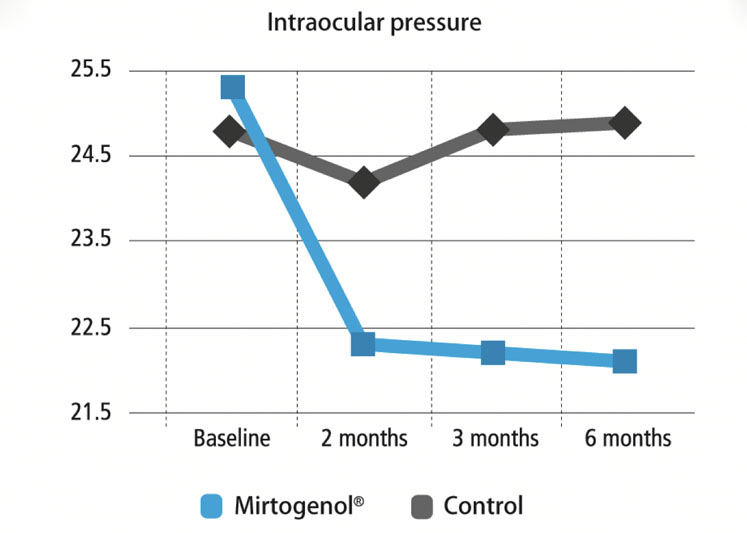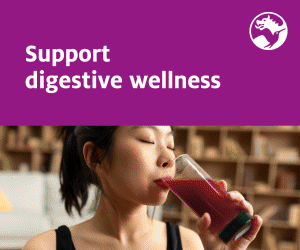In 2014, WHO and the International Agency for the Prevention of Blindness implemented a global action plan called “VISION 2020: The Right to Sight.” The goal of this joint global initiative is to increase awareness of avoidable blindness and reduce it by 25% by 2020.2
Regional and national events such as the World Glaucoma Week were established to help to address the global problem of sight impairment and to facilitate a broad range of supporting activities.3,4
Glaucoma is the third most common cause for blindness worldwide after cataract and uncorrected refractive error.2 Glaucoma is a group of eye conditions that damage the optic nerve, the health of which is vital for good vision.
This damage is often caused by an abnormally high pressure in the eye.5 Insufficient blood supply owing to increased intraocular pressure (IOP) or reduced ocular blood flow (OBF) are considered to be major treatable risk factors for glaucoma.6
Damage caused by glaucoma cannot be reversed. Therefore, lowering the IOP is the only proven method to avoid irreversible damage. Treatments may include prescription eye drops, oral medications or surgery, but oral supplementation is becoming increasingly popular among consumers looking at natural alternatives.5
Mirtogenol, the patented combination of Mirtoselect (bilberry extract) and Pycnogenol (French maritime pine bark extract) is one of the first nutritional approaches developed to address eye health.
In several studies, Pycnogenol has been shown to positively affect eye health by strengthening retinal capillaries. Maintaining healthy retinal capillaries helps to control the leakage of fluids and blood into the retina.7
Mirtoselect was also shown to have a positive impact on eye health by improving tear secretion and plasmatic antioxidant potential in subjects suffering from dry eye disease (DED) symptoms.8
Clinical trials
In five clinical studies on more than 200 patients, Mirtogenol showed significant effects on intraocular pressure (IOP) and ocular blood flow (OBF).9–13
A clinical pilot study with 38 asymptomatic subjects with intraocular hypertension showed that after 2 months of supplementation with Mirtogenol, the intraocular pressure (measured in mmHg) was notably lowered.9
After 3 months, the reduction was significant compared with the control patients and, by that time, 19 out of 20 patients taking Mirtogenol had decreased IOPs. The effects on ocular blood flow were similarly improved after 2 months — both systolic and diastolic — in different ocular arteries.
Three months of Mirtogenol supplementation significantly increased arterial flow velocity compared with both baseline and control group, in which no alteration of flow velocity was found.
For a total of 6 months, the subjects were supplemented with two Mirtogenol capsules per day that contained 40 mg of Pycnogenol and 80 mg of Mirtoselect each.
The study suggests that the use of Mirtogenol is a safe and preventive solution for lowering the risk of developing symptomatic glaucoma by controlling intraocular pressure and improving ocular blood flow (Figure 1).

Figure 1: Reduction of intraocular pressure with time in subjects supplementing with Mirtogenol
Another 6-month study with 79 patients with asymptomatic ocular hypertension investigated the effect of a lower dose of Mirtogenol (40 mg of Pycnogenol and 80 mg of Mirtoselect) per day for intraocular pressure in patients medicated with latanoprost eye drops.10
Latanoprost is used to treat increased pressure inside the eye, including ocular hypertension and open angle glaucoma. It is a prostaglandin analogue and increases the outflow of aqueous fluid from the eyes.14
In addition to latanoprost eye drops, some patients were also medicated with Mirtogenol. The investigators found that Mirtogenol potentiates the beneficial effect of latanoprost regarding IOP by 18% and diastolic and systolic ocular blood flow by 40% and 9%, respectively.
This research suggests a beneficial effect of the regular combined intake of Mirtogenol and latanoprost for eye health after 6 weeks, and even better results after 6 months of supplementation.
A study with 88 asymptomatic patients with intraocular hypertension investigated the effect of 3 months of Mirtogenol supplementation (two capsules/day) in association with traditional antihypertensive drugs (dorzolamide-timolol or latanoprost eye drops) on retinal microcirculatory parameters and oxidative stress.11
After 6 weeks, the study showed a positive clinical effect on intraocular pressure and the ocular blood flow when supplementing with Mirtogenol in addition to latanoprost.
Another 6 weeks later, at the end of the study, 58.1% of the subjects treated with Mirtogenol and latanoprost had normal IOP levels (compared with 41.4% in the latanoprost-only patient group).
Oxidative stress levels (measured as plasma free radicals) were reduced by 17% compared with baseline when supplementing with Mirtogenol.
Both diastolic and systolic ocular blood flow improved by 63% and 24%, respectively, when compared with non-supplemented patients. The authors concluded that supplementing with Mirtogenol, in addition to standard ophthalmic treatments, improves ocular microcirculatory parameters with faster and greater effects compared with non-supplemented single managements and may help to lower intraocular pressure to normal levels.
A placebo-controlled, prospective, double-blind, randomised study from 2017 investigated the effect of Mirtogenol supplementation on the changes in retinal nerve fibre layer (RNFL) thickness and visual field.12
Forty one patients with primary open angle glaucoma with controlled intraocular pressure levels were supplemented with Mirtogenol for 2 months (in addition to their glaucoma medications).

At the end of the study, Mirtogenol maintained RNFL thickness with an insignificant decrease of 0.8%; in the placebo group, a significant thinning of the RNFL by 1.8% was observed. According to the authors, a decrease of RNFL thickness by 10–12% is related to a glaucomatous change of 1.5-fold.
The mean deviation of visual fields in the Mirtogenol group increased by 29.6% after 2 months; in the placebo group, it decreased by 6.9%. A decrease of the mean deviation of the visual field of 1.4% per month indicates glaucoma progression.
This study showed further beneficial effects of Mirtogenol for eye health as part of addressing risks factors associated with glaucoma.
A recent study from 2021 analysed the intraocular pressure lowering effects of Mirtogenol in 18 Japanese patients (29 eyes) with increased IOP.13 The patients were supplemented with Mirtogenol (40 mg of Pycnogenol and 90 mg of Mirtoselect) in addition to their individual antiglaucoma medication.
After 4 weeks, their IOPs decreased by a significant 8.7%, showing a promising beneficial effect of Mirtogenol on one of the major risk factors associated with glaucoma.
References
- www.who.int/publications/i/item/world-report-on-vision.
- P. Ackland, S. Resnikoff and R. Bourne, "World blindness and Visual Impairment: Despite Many Successes, the Problem is Growing," Community Eye Health 30(100), 71–73 (2017).
- https://wga.one/wga/world-glaucoma-week.
- R.R.A. Bourne, "Vision 2020: Where Are We?" Curr. Opin. Ophthalmol. 31(2), 81–84 (2020).
- R.N. Weinreb, T. Aung and F.A. Medeiros, "The Pathophysiology and Treatment of Glaucoma: A Review," JAMA 311(18), 1901–1911 (2014).
- J. Flammer, et al., "The Impact of Ocular Blood Flow in Glaucoma," Prog. Retin. Eye Res. 21(4), 359–393 (2002).
- F.R.P. Schönlau, "Pycnogenol for Diabetic Retinopathy: A Review," Int. Ophthalmol. 24, 161–171 (2002).
- A. Riva, et al., "The Effect of a Natural, Standardized Bilberry Extract (Mirtoselect®) in Dry Eye: A Randomized, Double-Blinded, Placebo-Controlled Trial," Eur. Rev. Med. Pharmacol. Sci. 21(10), 2518–2525 (2017).
- R.D. Steigerwalt, et al., "Effects of Mirtogenol on Ocular Blood Flow and Intraocular Hypertension in Asymptomatic Subjects," Mol. Vis. 14, 1288–1292 (2008).
- R.D. Steigerwalt, et al., "Mirtogenol Potentiates Latanoprost in Lowering Intraocular Pressure and Improves Ocular Blood Flow in Asymptomatic Subjects," Clin. Ophthalmol. 4, 471–476 (2010).
- C. Gizzi, et al., "Mirtogenol® Supplementation in Association with Dorzolamide-Timolol or Latanoprost Improves the Retinal Microcirculation in Asymptomatic Patients with Increased Ocular Pressure," Eur. Rev. Med. Pharmacol. Sci. 21(20), 4720–4725 (2017).
- A. Widyakusuma, et al., "The Effect of Mirtogenol Towards the Changes in Retinal Nerve Fiber Layer Thickness and Visual Field in Primary Open Angle Glaucoma," Ophthalmologica Indonesiana 43(1), 28 (2019).
- K. Manabe, et al., "Effects of French Maritime Pine Bark/Bilberry Fruit Extracts on Intraocular Pressure for Primary Open-Angle Glaucoma," J. Clin. Biochem. Nutr. 68(1), 67–72 (2021).
- S.S. Patel and C.M. Spencer, "Latanoprost: A Review of Its Pharmacological Properties, Clinical Efficacy and Tolerability in the Management of Primary Open-Angle Glaucoma and Ocular Hypertension," Drugs Aging 9(5), 363–378 (1996).




